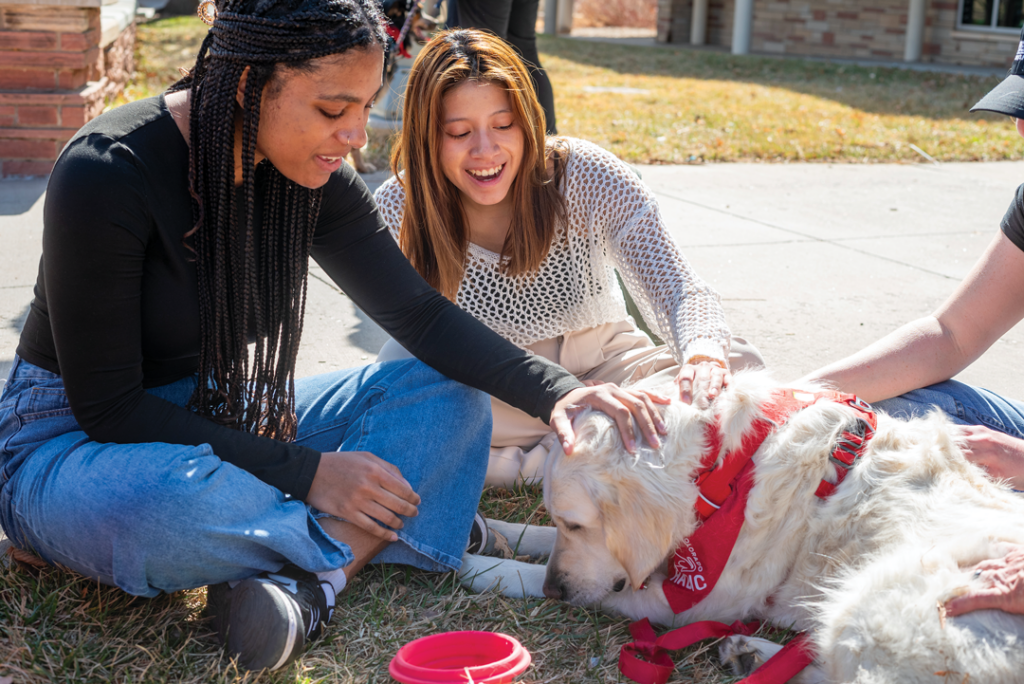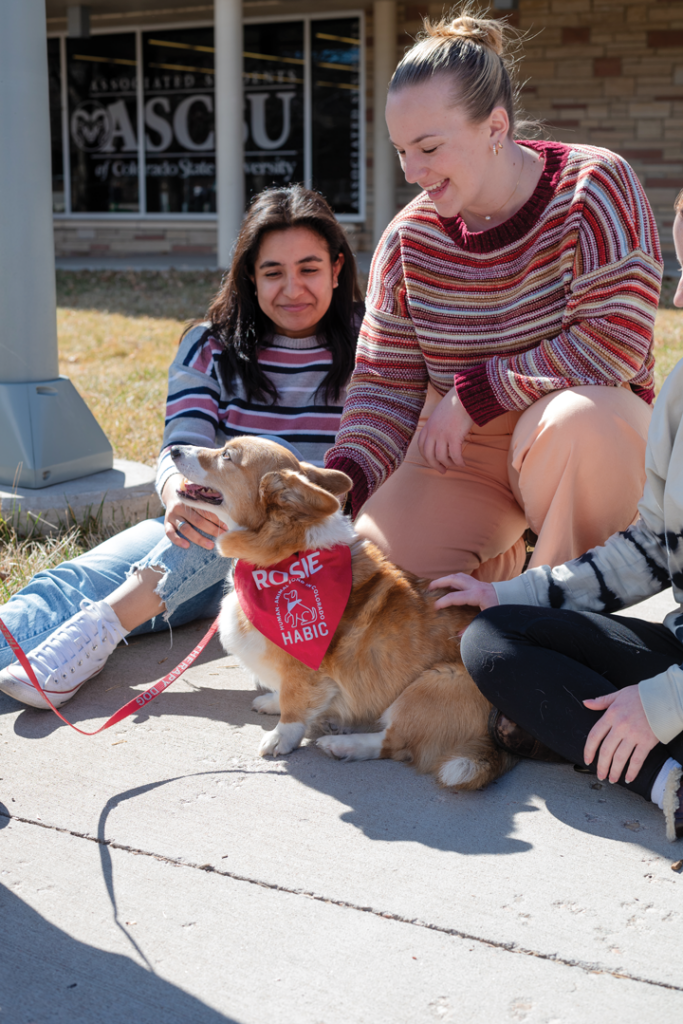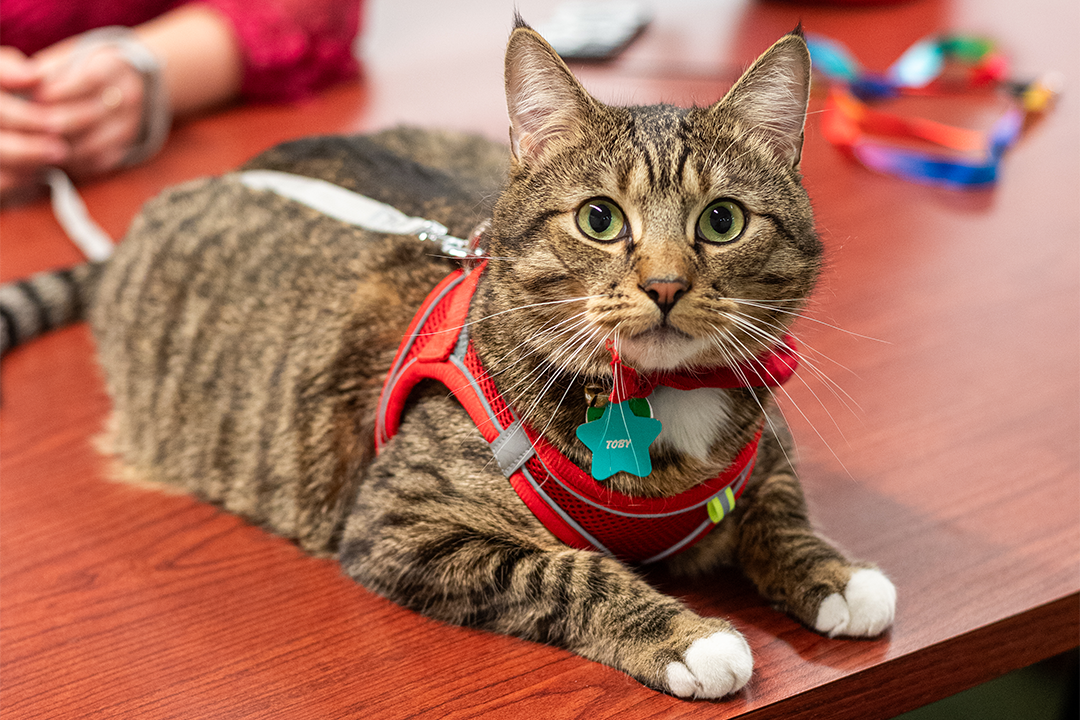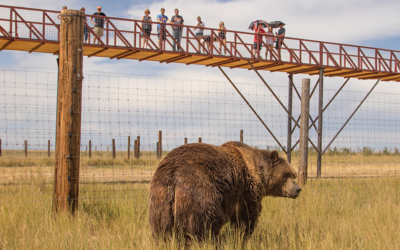This should make you feel better the next time you choose jammies, trash TV and a box of Cinnamon Toast Crunch over drinks with your besties: Even golden retrievers get tired of people.
Human-Animal Bond in Colorado (HABIC) brings therapy dogs to places full of people who need them, including schools and hospitals. They typically bring four or five dogs to each place. That means one dog might see dozens, if not hundreds, of people, and it’s why they limit sessions to an hour.
Not only is that a lot of love for anyone to handle, but the dogs soak up a lot of stress, anxiety and even pain. By the end of the hour, they are happy and exhausted. The people are also happy, and they’re usually refreshed. That’s the power of the human-animal bond, say workers from the organization, a branch of Colorado State University’s School of Social Work.
HABIC advocates for developing the relationship between humans and animals. The organization educates groups about the benefits of the bond, sponsors research about it and finds ways to advance the benefits of it.
“We’re not snuggling with golden retrievers all day,” says Tricia Howley, the organization’s office coordinator.
They wouldn’t mind doing that, of course. The profiles of the small staff on HABIC’s website are accompanied by photos of them with their pets. But there’s too much work to do.

Arianna Dickerson and Cristina Hoffman petting Bella. Photo by Jordan Secher.
Exploring the human-animal bond
Researching what our pets mean to us seems like a no-brainer—Disney alone has made billions off those stories—and yet, there’s only recently been a lot written or said about how vital the bond is for both humans and domesticated animals. For example, Christopher McDougall, author of the seminal running book, “Born To Run,” wrote about the subject in his 2019 book, “Running With Sherman.”
HABIC celebrated 30 years in 2023, making the organization part of a small group of pioneers who wanted to explore the relationships we have with our pets on a deeper level.
“We’ve been here 30 years, but people didn’t know we were here,” says Helen Holmquist-Johnson, the organization’s director. “We are working to change that.”
A sunny day in March was one small step toward that, as HABIC volunteers parked themselves and their pets at the Lory Student Center on CSU’s campus and waited for students to shyly approach and ask if they could pet their dogs. Laurel Hageseth, of Fort Collins, and her dog, Gyp, a 6-year-old border collie and Australian shepherd mix, were all for it. Hageseth named Gyp after the best horse she ever rode.
“I knew she had the capability,” Hageseth says of Gyp being a therapy dog. “She comforts and hugs us whenever we aren’t feeling good.”
Hageseth recognized the qualities from her experience as an obedience trainer and owner of a grooming and nail trimming business, Have Dremel Will Travel. Gyp is a working breed, and the job helps keep her brain busy.
“She loves to learn,” Hageseth says.
It’s not just dogs, either. McDougall’s pet, Sherman, is a donkey, and he writes about goats and their amazing ability to bond as well. Some cats are just as good as dogs at comforting people, and HABIC has just the cat to prove it: Toby.
Toby relished the attention from a group of students who gathered around him. One of them, Erin Vestecka, a senior who lives in Loveland, let out a shriek when she entered the room where Toby prowled on a table. He hopped on her lap as soon as she sat down. Vestecka had a long day on campus, away from her own cat, and needed a little feline time.
“I can feel the happiness chemicals flooding through my body,” Vestecka said as she cuddled with Toby.
Toby and his owner, Antonella Torres Peralta, are just as grateful for the program as Toby’s fan club. Torres Peralta had to teach him a few things, but he took to a leash and many other tricks right away. She believes Toby loves the stimulation from the events.
“He’s a little too smart for a cat,” Torres Peralta says. “I wanted more for him. He’s definitely more gentle now. He would never bite a stranger, but he was biting me, I think because he was bored. He doesn’t bite now.”

Yesenia Enriquez and Anna Higgins with Rosie.
Photo by Jordan Secher.
Animals as therapy
Trained animals have been known to help abused kids talk about the horrible things they’ve experienced, and they’ve helped sooth victims through some of the worst events of our time. Dogs, for instance, can provide comfort to those who’ve experienced school shootings.
Therapists also use animals to help patients who struggle with anxiety, depression and loneliness. Some are trained to spend time with hospice patients. College students are at a higher risk of becoming depressed, according to HABIC, and the regular visits they receive from therapy dogs help stave it off. Some students have shared with the organization that their dogs were the only thing getting them out of bed.
HABIC recently fought hard to bring their animals back to hospitals, and as of last fall, they were finally allowed back in patients’ rooms again. Hospitals had concerns after the COVID-19 pandemic and were some of the last to welcome pets and their handlers back into their facilities, even when nurses and doctors desperately needed the few minutes they spent in the lobby with the therapy dogs during the worst parts of the pandemic.
Now HABIC has more than 150 human-animal teams that visit hospitals, nursing homes, trauma sites and schools. They help patients physically and mentally (even brushing a dog is therapeutic for both parties), and they teach students about confidence, empathy and forming attachments. The organization trains volunteers to handle the animals and even offers a graduation certificate for students studying to become therapists who want to use animals in therapy.
The dogs do get perks. Local Girl Scout troops make snuffle mats (a mat with strips of fabric that encourage dogs to scrounge and sniff) to help them decompress after a session in the same way that students play Fortnite after school. But they don’t always seem to need them.
As the hour wrapped up, a student walked up to Hageseth and asked to pet Gyp. She sat on the grass, and Gyp was already in her lap.
“This isn’t a job,” Hageseth says. “This is fun.”







